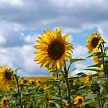
Helianthus
Symbol of the sun
| Latin name | Helianthus |
| Alternative name | Sunflowers |
| Homeland | North America (southern regions) |
| Family | Compositae |
| Cultivation | simple |
| Location | in the open sun |
| Temperature | optimal 20-22 °C |
| Watering | moderate |
| Flowering time | in summer |
| Height | from 15 cm to 4 m |
| Transplanting | not performed |
| Appearance maintenance | general hygiene measures |
The genus Sunflower (Helianthus) consists of fifty annual and perennial grasses, semi-shrubs and shrubs. The most interesting of them is the sunflower oil (Helianthus annuus) - an annual species, from which many decorative forms were derived, which will be discussed. This plant is drought-and wind-resistant, which is provided by its deep-penetrating root system. In the inflorescence-basket there are up to 1000 flowers: marginal lingual yellow and chestnut or purple median. Blooms in summer, then fruits (achenes) are formed. Among the most interesting decorative ones: forms: 'Double' with double baskets, 'Italian white' with light yellow tongue flowers, 'Sunny gold' with golden yellow tongue flowers. There are cultivars with reddish-chestnut or almost black flowers. The impressive (up to 4 m in height) Russian Giant variety has huge (up to 50 cm in diameter) baskets. In addition, various low forms designed for growing in pots were developed. H. decapitalus is a perennial species with light yellow flower baskets 5-8 cm in diameter.
The genus Sunflower (Helianthus) consists of fifty annual and perennial grasses, semi-shrubs and shrubs. The most interesting of them is the sunflower oil (Helianthus annuus) - an annual species, from which many decorative forms were derived, which will be discussed. This plant is drought-and wind-resistant, which is provided by its deep-penetrating root system. In the inflorescence-basket there are up to 1000 flowers: marginal lingual yellow and chestnut or purple median. Blooms in summer, then fruits (achenes) are formed. Among the most interesting decorative ones: forms: 'Double' with double baskets, 'Italian white' with light yellow tongue flowers, 'Sunny gold' with golden yellow tongue flowers. There are cultivars with reddish-chestnut or almost black flowers. The impressive (up to 4 m in height) Russian Giant variety has huge (up to 50 cm in diameter) baskets. In addition, various low forms designed for growing in pots were developed.
H. decapitalus is a perennial species with light yellow flower baskets 5-8 cm in diameter.
Cultivation
Sunflowers are open ground plants, as they are tall (up to 1.5 m) and have a powerful root system, but low ones can be grown in pots as annuals. Perennial species are left to winter in the ground, and annuals are sown annually only after the frost stops.
Location
This plant develops well only in the open sun.
Temperature
Optimal temperature for growth: 20-22 °C. Decorative forms are afraid of significant cold snaps during the rest period.
Watering
Sunflowers do not like excessive humidity, so they are watered moderately. In general, these plants tolerate periods of drought well.
Reproduction
In May, sunflower seeds are sown in the open ground. By dividing the bush, only perennial species can be propagated-in autumn or spring. Both garden soil and potted soil should be provided with good drainage.
Diseases
Plants should be protected from snails by using metaldehyde-based preparations. Among fungal diseases, the most common are rust (brownish pustules form on the reverse side of the leaves, which subsequently turn black), peronosporosis, and gray rot. They are disposed of with appropriate fungicides. The main enemy of plants grown from seeds is birds. Therefore, seeds should be covered with a net or use appropriate repellents.
Acquisition
For growing in pots, buy seeds of stable and not too tall varieties (they require supports). In the spring, you can also get seedlings in pots. Buy very compact specimens, without spots or yellowing of the leaves.